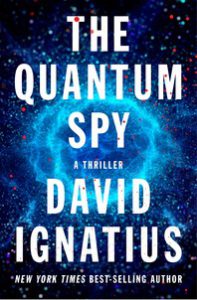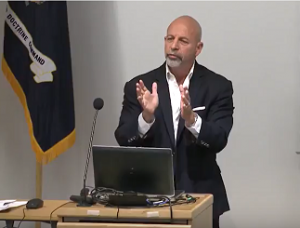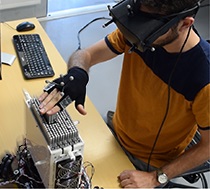[Editor’s Note: Mad Scientist Laboratory is pleased to present (somewhat belatedly) our July edition of “The Queue” – a monthly post listing the most compelling articles, books, podcasts, videos, and/or movies that the U.S. Army’s Training and Doctrine Command (TRADOC) Mad Scientist Initiative has come across during the past month. In this anthology, we address how each of these works either informs or challenges our understanding of the Future Operational Environment. We hope that you will add “The Queue” to your essential reading, listening, or watching each month!]
1.  “P.W. Singer: Adapt Fast, or Fail,” by Brendan Nicholson, Australian Strategic Policy Institute, 7 July 2018.
“P.W. Singer: Adapt Fast, or Fail,” by Brendan Nicholson, Australian Strategic Policy Institute, 7 July 2018.
Mr. Nicholson summarizes a recent presentation by one of our favorite Mad Scientists, P.W. Singer from New America. Mr. Singer warns that as more and more items are linked to the internet of things, the opportunities for nations and societies (also non-state actors and super-empowered individuals) to attack and be attacked become much broader. He states that “all of this technology does not mean that we will see humans eliminated from war anytime soon. Rather, just like the steam engine and the plane and the computer, we will see changes in the human skills that are most needed and less needed. This movement of people skills can and should change everything from our recruiting and training to our doctrine and organizational design.” This movement of people skills was a key aspect of last week’s Mad Scientist Learning in 2050 Conference, conducted at Georgetown University on 8 – 9 August. The demands on Leaders and skills required to compete in the changing character of war are probably fundamentally different. Mr. Singer challenges us to choose real change and not change just enough to fail. His example of the USS Arizona with its two catapult-launched float planes demonstrates a bureaucracy’s incremental approach in the face of revolutionary change. That change – modern bombers – made this once great warship a monument to a “Day that will live in Infamy.”

2. The Quantum Spy: A Thriller, by David Ignatius, W. W. Norton & Company, Inc., 17 November 2017.
David Ignatius, famed spy novelist and Washington Post journalist, tackles not only espionage but also a multitude of disruptive technologies in his new thriller, The Quantum Spy. The book revolves around a race towards leap-ahead developments in quantum computing between the United States and China; but a looming subplot is the cat and mouse game of counterintelligence, infiltration, and insertion of moles between the Central Intelligence Agency and the Chinese Ministry of State Security. CIA case officer and Army veteran Harris Chang struggles with his Chinese heritage, devotion to America, and the sometimes unscrupulous role of his organization in fighting to protect America’s secrets. The book is replete with detailed and accurate descriptions of American innovation efforts. The depiction of the infiltration on American college campuses and research institutions by foreign students being sponsored and often directed by foreign adversaries is alarming and timely given recent real-world events such as a Chinese student taking groundbreaking work on metamaterials at Duke University back to his home country. The book raises important questions about the balance between open, collaborative innovation (that opens up a number of vulnerabilities) and more restrictive, government-funded research (that may be more secure), both of which are critical in the current Era of Accelerated Human Progress (now through 2035) as described in The Operational Environment and the Changing Character of Future Warfare. Similarly to Agents of Innocence and Body of Lies, David Ignatius has created a work that not only features a fantastic story but that includes many government, military, and intelligence implications.

3. “War and the Human Brain” podcast with Dr. James Giordano and Mr. John Amble, Modern War Institute, 24 July 2018 (originally aired in 2017) – review by Marie Murphy.
Modern War Institute’s John Amble spoke with Dr. James Giordano about his research in neuroscience and using “the brain as a weapon” following his presentation at the Mad Scientist Visualizing Multi Domain Battle in 2030-2050 Conference, 25-26 July 2017, at Georgetown University, Washington, D.C. After a brief historical overview of neuroscience’s military applications, Dr. Giordano explains how recent research on electric and magnetic trans-cranial stimulation and implantable electrodes has opened up possibilities and controversies. Soldiers of the future could obtain modifications that improve memory, cognition, and vigilance while decreasing fatigue. Conversely, there is an ethical dilemma when it comes to discontinuing, removing, or deactivating these improvements; there is concern regarding the Soldier potentially feeling disabled or disenabled afterwards. The discussion transitioned to the implications of “drugs, bugs, toxins, and tools,” all of which can have some kind of effect on neurological activity, and all of which can be weaponized. These capabilities, while not considered weapons of mass destruction, are categorized as weapons of mass disruption. These tools and technologies pose a real, rising threat in the future Operational Environment; are deployable by nation-states, non-state actors, and super-empowered individuals; and can be specifically targeted for optimal impact. Read more about these capabilities in the Mad Scientist Bio Convergence and Soldier 2050 Conference Final Report.

4. “Creating Genetically Modified Babies Is ‘Morally Permissible,’ Says Ethics Committee,” by Kristin Houser, Futurism, 17 July 2018.
On 17 July 2018, the UK’s Nuffield Council on Bioethics issued a press release in conjunction with their publication of Genome editing and human reproduction. The Council, established in 1991 to address ethical issues raised by new developments in biology and medicine, “concluded that editing the DNA of a human embryo, sperm, or egg to influence the characteristics of a future person (‘heritable genome editing’) could be morally permissible.” Futurism interpreted this as meaning we are “one step closer to designer babies,” and concluded it “is a promising sign for anyone eager for the day gene-editing lets them create the offspring of their dreams.” That said, the Council recommends two overarching principles governing the ethical use of heritable genome editing: “they must be intended to secure, and be consistent with, the welfare of the future person; and they should not increase disadvantage, discrimination or division in society.” The Council also noted that current British law precludes the genomic editing of embryos that are to be placed in a womb. So, no Brave New World in our future, right?
Not necessarily.… As Mr. Hank Greely, Professor of Law, Stanford University, pointed out this spring at our Mad Scientist Bio Convergence and Soldier 2050 Conference, we are on the cusp of being able to use skin cells to generate lines of viable embryos, which then may be subjected to Preimplantation Genetic Diagnoses prior to selection and implantation to preclude a host of genetic diseases and ensure healthier babies (who could possibly object to that?). With the advent of genetic editing and artificial wombs, we will be able to manipulate the genomic coding of any given embryo (initially to address genetic disease, but eventually to enhance capabilities), implant it, and then “decant” the resulting progeny. Sound farfetched? At the same conference, Ms. Elsa Kania, CNAS, noted that the PRC is currently gene editing human embryos and conducting human clinical trials. Their Bio-Google Initiative (BGI) is soliciting DNA from their geniuses in an attempt to understand the genomic basis for intelligence. With the advent of genetically enhanced humans, it is conceivable that we could face adversaries in the Deep Future Operational Environment with warrior caste soldiers, each modified genetically as embryos for greater strength, endurance, and combat performance in complex and extreme environments (e.g., high / low temperatures, low atmospheric pressures) and with optimized Brain Computer Interfaces. Previous regimes sought to populate their forces with “Supermen” — genomic editing may provide future regimes with the post-industrial means of accomplishing this objective “ … by the lights of perverted science.”

5. “This VR Horror Game Is Exactly as Scary as Your Body Can Handle,” by Kristin Houser, Futurism, 22 July 2018.
Red Meat Games released its fifth virtual reality (VR) project, Bring to Light. Developers designed the VR horror game to push players to their terror limits with the help of a biometric sensor. Right now, Bring to Light is the first VR game to use biometric feedback to effect gameplay; it calls to mind the Black Mirror episode “Playtest,” a near-future cautionary tale of the risks associated with combining VR and Augmented Reality (AR) with gaming. In spite of this, AR and VR will become more integrated and player involved. As discussed in last month’s edition of “The Queue,” VR has the potential to also accelerate learning and enhance retention when used to train our Soldiers and Leaders.

6. “’Shapeshift’ lets you feel objects that aren’t there” video, C/NET, 21 July 2018.
Stanford University is working on a technology known as “Shapeshift” that presents users with a haptic “touch” interface that provides a bridge between VR and the physical world. Shapeshift is a high-resolution, compact, modular shape display consisting of 288 actuated pins (4.85mm×4.85mm, 2.8mm inter-pin spacing) formed by six 2×24 pin modules. It is reminiscent of pin art toys played with by children and adults alike for years. The interface will allow users to truly feel the objects they see and interact with in VR, bringing about an entirely new level of immersion into constructed virtual or augmented worlds. The implications for accurate and intuitive modeling, design, simulation, and training are astounding. In the future, such interfaces could be utilized in vehicles, on or with weapons, and integrated in classrooms and other training venues.

7. Smart Bandages designed to monitor and tailor treatment for chronic wounds, by Mike Silver / Tufts University, TuftsNow, 6 July 2018.
Engineers from Tufts University have re-designed the bandage with the intent of taking it from a passive treatment to an active treatment for chronic wounds. These skin wounds can be from burns, diabetes, or other medical conditions that overwhelm the normal regenerative capabilities of the skin. The bandage monitors the pH and temperature and can administer drugs when either goes out of normal range. While the bandage treats only certain chronic skin conditions at present, it is easy to see future implications of this technology, especially in Soldiers on the battlefield. Persistent or serious wounds can be monitored and treated in real-time without needing to take the Soldier out of the fight or waiting for medical advice and treatment from a professional. This could reduce cost and recovery time. What is the next step beyond smart bandages? Will it be feasible to have general health sensors and a variety of treatments embedded on the Soldier in the future?
If you read, watch, or listen to something this month that you think has the potential to inform or challenge our understanding of the Future Operational Environment, please forward it (along with a brief description of why its potential ramifications are noteworthy to the greater Mad Scientist Community of Action) to our attention at: usarmy.jble.tradoc.mbx.army-mad-scientist@mail.mil — we may select it for inclusion in our next edition of “The Queue”!



